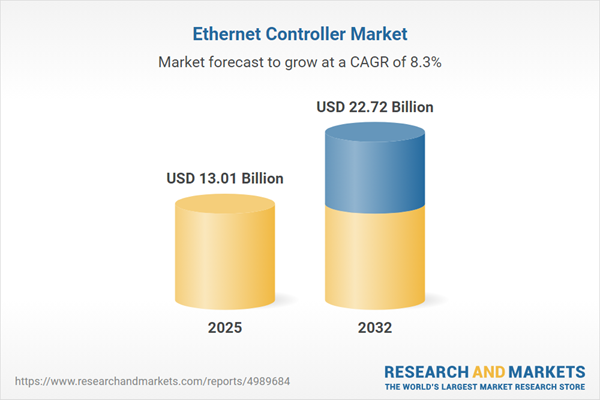Speak directly to the analyst to clarify any post sales queries you may have.
As digital transformation deepens across industries, senior decision-makers face escalating network demands. The Ethernet controller market plays a critical role by underpinning organizational needs for secure, agile connectivity, ensuring networks can adapt to changing business priorities.
Market Snapshot: Ethernet Controller Market Overview
The Ethernet controller market is experiencing notable expansion, driven by the fusion of advanced networking technologies and broader application of automation. Global market revenue is projected to grow from USD 12.02 billion in 2024 to USD 13.01 billion in 2025, achieving USD 22.72 billion by 2032 at a compound annual growth rate of 8.28%.
Core factors fueling this trend include the urgent need for greater data throughput, a rising focus on enterprise scalability, and accelerated edge computing deployments. Established suppliers are ramping up research and development to introduce controllers that enhance data management, ensure consistent network performance, and boost operational efficiency in multiple sectors.Scope & Segmentation of the Ethernet Controller Market
This report offers an in-depth examination of the Ethernet controller market for technology and business leaders seeking to align infrastructure investment with evolving demands. Segmentation provides clarity on where innovation and procurement focus should be directed:
- Controller Type: Selection spans 2.5 to 100 Gigabit Ethernet, as well as intermediate 5, 10, 25, and 40 Gigabit models. These serve varied organizational setups, from supporting distributed branch operations to handling core data center workloads in centralized environments. The diversity allows targeted deployment, optimizing performance and scalability.
- Interface Options: A range of connectivity standards is covered, including PCIe Gen6, USB4, CXL, Thunderbolt 5, M.2, OCP, and legacy ports. These enable seamless integration into both legacy and forward-looking network architectures, with flexibility for future technology upgrades and backward compatibility to safeguard previous infrastructure investments.
- Industry End-Use: The market addresses requirements across automotive, data center, healthcare, government, IT and telecom, manufacturing, and retail sectors. Each vertical faces unique regulatory, performance, and resilience challenges, influencing network selection and ongoing adaptation of Ethernet solutions.
- Regional Markets: Market adoption is assessed in the Americas, EMEA, and Asia-Pacific regions. These regions exhibit differences in infrastructure readiness, regulatory priorities, and economic growth, impacting the adoption strategies and procurement timelines for Ethernet controllers.
- Leading Companies: Strategies from top companies—including Intel Corporation, Broadcom Inc., Marvell Technology Inc., Realtek Semiconductor Corp., Microchip Technology Incorporated, NVIDIA Corporation, NXP Semiconductors N.V., Qualcomm Incorporated, Texas Instruments Incorporated, and Infineon Technologies AG—are analyzed, emphasizing innovation in controller interoperability, security, and sector-specific customization.
Key Takeaways for Ethernet Controller Market Strategy
- Modern Ethernet controllers are foundational to digital transformation, providing the flexible architectures required for resilient network environments.
- Shifts towards software-defined networking and virtualization empower enterprises with enhanced control, supporting secure and efficient use of networking resources.
- Evolving partnerships and integration with cloud services, emergence of 5G support, and increased emphasis on sustainability are shaping industry collaboration and influencing procurement decisions.
- Support for new interface standards helps organizations bridge the gap between older and advanced network assets, reducing disruption during technology transitions.
- Joint efforts between semiconductor manufacturers and software developers lead to specialty solutions, particularly for industries with strict compliance or data security needs.
- Maintaining high standards for data protection and business continuity keeps Ethernet controllers central to risk management and operational stability plans.
Tariff Impact on Ethernet Controller Supply Chains
Amendments in U.S. trade policy are causing organizations to rethink global sourcing and production strategies linked to Ethernet controller procurement. Senior leaders are prioritizing supplier reliability, operational logistics, and compliance measures to address supply chain risks and ensure ongoing operational continuity.
Methodology & Data Sources
This market research integrates the latest insights from technology trend analysis, interviews with executive leadership, patent activity reviews, and an examination of industry publications. Every insight feeds into robust recommendations for strategic infrastructure planning.
Why This Report Matters
- Supports effective benchmarking and informed investment allocation by providing actionable segmentation for Ethernet controller deployment across varied organizational needs.
- Enables technology executives to navigate intricate compliance environments and manage emerging supply chain risks, allowing confident modernization of network infrastructure.
- Prepares organizations to enhance compliance and risk management processes, upholding operational advantage and resilience in dynamic markets.
Conclusion
This report delivers strategic insight for decision-makers aiming to future-proof enterprise networks, enabling data-driven investments while supporting evolving connectivity needs and sustained operational success.
Additional Product Information:
- Purchase of this report includes 1 year online access with quarterly updates.
- This report can be updated on request. Please contact our Customer Experience team using the Ask a Question widget on our website.
Table of Contents
3. Executive Summary
4. Market Overview
7. Cumulative Impact of Artificial Intelligence 2025
Companies Mentioned
The companies profiled in this Ethernet Controller market report include:- Intel Corporation
- Broadcom Inc.
- Marvell Technology, Inc.
- Realtek Semiconductor Corp.
- Microchip Technology Incorporated
- NVIDIA Corporation
- NXP Semiconductors N.V.
- Qualcomm Incorporated
- Texas Instruments Incorporated
- Infineon Technologies AG
Table Information
| Report Attribute | Details |
|---|---|
| No. of Pages | 186 |
| Published | October 2025 |
| Forecast Period | 2025 - 2032 |
| Estimated Market Value ( USD | $ 13.01 Billion |
| Forecasted Market Value ( USD | $ 22.72 Billion |
| Compound Annual Growth Rate | 8.2% |
| Regions Covered | Global |
| No. of Companies Mentioned | 11 |









